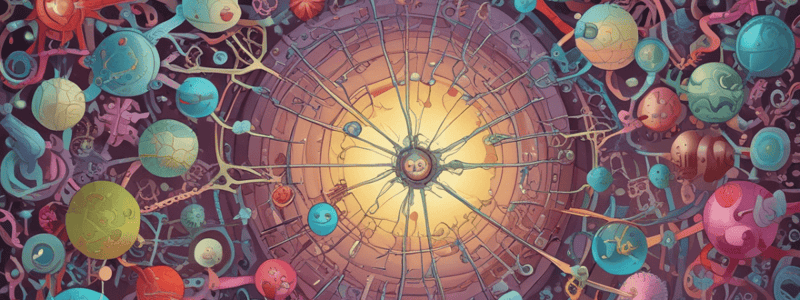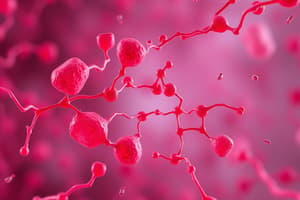Podcast
Questions and Answers
What percentage of heme is obtained from hemoglobin in the body?
What percentage of heme is obtained from hemoglobin in the body?
- 70%
- 60%
- 90%
- 80% (correct)
Which of the following is NOT a source of heme in the body?
Which of the following is NOT a source of heme in the body?
- Myoglobin
- Cytochrome
- Chlorophyll (correct)
- Hemoglobin
What is the organic compound found in heme?
What is the organic compound found in heme?
- Carotenoid
- Porphyrin (correct)
- Bilirubin
- Chlorophyll
Which bodily substances contain bilirubin?
Which bodily substances contain bilirubin?
What is the term for the structure formed by the connection of four pyrrols rings in heme?
What is the term for the structure formed by the connection of four pyrrols rings in heme?
How many pyrrols-like rings are present in bilirubin?
How many pyrrols-like rings are present in bilirubin?
What is the fate of hemoglobin in the spleen?
What is the fate of hemoglobin in the spleen?
What is the characteristic of unconjugated bilirubin in terms of solubility?
What is the characteristic of unconjugated bilirubin in terms of solubility?
Where is unconjugated bilirubin formed?
Where is unconjugated bilirubin formed?
What is the role of albumin in relation to unconjugated bilirubin?
What is the role of albumin in relation to unconjugated bilirubin?
What is the product of heme ring breakdown?
What is the product of heme ring breakdown?
What is the purpose of conjugating bilirubin with glucouronic acid in the liver?
What is the purpose of conjugating bilirubin with glucouronic acid in the liver?
What is the eventual destination of conjugated bilirubin in the body?
What is the eventual destination of conjugated bilirubin in the body?
What is the role of the bile duct in the conjugation process of bilirubin?
What is the role of the bile duct in the conjugation process of bilirubin?
What is the result of the reaction between bilirubin and glucouronic acid in the liver?
What is the result of the reaction between bilirubin and glucouronic acid in the liver?
What is the primary function of enterohepatic circulation in the context of bile?
What is the primary function of enterohepatic circulation in the context of bile?
What is the primary contributor to the characteristic brown color of feces?
What is the primary contributor to the characteristic brown color of feces?
What is the fate of conjugated bilirubin that remains in the large intestine?
What is the fate of conjugated bilirubin that remains in the large intestine?
What is the significance of elevated levels of bilirubin in blood and urine?
What is the significance of elevated levels of bilirubin in blood and urine?
How do indirect and direct bilirubin react with a reagent?
How do indirect and direct bilirubin react with a reagent?
What is the formula for total bilirubin?
What is the formula for total bilirubin?
What is the difference between the reaction of indirect bilirubin with a reagent and the reaction of direct bilirubin with a reagent?
What is the difference between the reaction of indirect bilirubin with a reagent and the reaction of direct bilirubin with a reagent?
What is the primary characteristic of jaundice?
What is the primary characteristic of jaundice?
How is jaundice classified according to the cause?
How is jaundice classified according to the cause?
What is affected by the yellow discoloration in jaundice?
What is affected by the yellow discoloration in jaundice?
What is the common factor among pre-hepatic, hepatic, and post-hepatic jaundice?
What is the common factor among pre-hepatic, hepatic, and post-hepatic jaundice?
What is the underlying cause of the yellow discoloration in jaundice?
What is the underlying cause of the yellow discoloration in jaundice?
What is the underlying cause of the elevated level of direct bilirubin in the blood and urine in post-hepatic obstructive jaundice?
What is the underlying cause of the elevated level of direct bilirubin in the blood and urine in post-hepatic obstructive jaundice?
Which of the following laboratory tests would confirm a diagnosis of hemolytic anemia as a cause of jaundice?
Which of the following laboratory tests would confirm a diagnosis of hemolytic anemia as a cause of jaundice?
What is the result of an increased rate of RBCs breakdown in the body?
What is the result of an increased rate of RBCs breakdown in the body?
What is the reason behind the high bilirubin level in newborns after 2-3 days?
What is the reason behind the high bilirubin level in newborns after 2-3 days?
What is the consequence of very high unconjugated bilirubin levels?
What is the consequence of very high unconjugated bilirubin levels?
Why is phototherapy used to treat high bilirubin levels?
Why is phototherapy used to treat high bilirubin levels?
What is the characteristic of the liver in Dubin-Johnson syndrome?
What is the characteristic of the liver in Dubin-Johnson syndrome?
What is the prognosis of Gilbert syndrome?
What is the prognosis of Gilbert syndrome?
What is the characteristic of bilirubin levels in Crigler-Najjar syndrome type 1?
What is the characteristic of bilirubin levels in Crigler-Najjar syndrome type 1?
What is the characteristic of Crigler-Najjar syndrome type 2?
What is the characteristic of Crigler-Najjar syndrome type 2?
What is the prognosis of Crigler-Najjar syndrome type 1?
What is the prognosis of Crigler-Najjar syndrome type 1?
What is the characteristic of bilirubin levels in patients with Gilbert syndrome?
What is the characteristic of bilirubin levels in patients with Gilbert syndrome?
What is the difference between Dubin-Johnson syndrome and Rotor syndrome?
What is the difference between Dubin-Johnson syndrome and Rotor syndrome?
What is the incidence of Gilbert syndrome in the population?
What is the incidence of Gilbert syndrome in the population?
What is the characteristic of Crigler-Najjar syndrome type 2?
What is the characteristic of Crigler-Najjar syndrome type 2?
What is the primary reason for performing a bilirubin test in newborns?
What is the primary reason for performing a bilirubin test in newborns?
How do you convert bilirubin levels from mg/dL to μmol/L?
How do you convert bilirubin levels from mg/dL to μmol/L?
What is the effect of hemolyzed sample on bilirubin levels?
What is the effect of hemolyzed sample on bilirubin levels?
What is the normal range of total bilirubin in adults in mg/dL?
What is the normal range of total bilirubin in adults in mg/dL?
Flashcards are hidden until you start studying
Study Notes
Bilirubin and Jaundice
- Bilirubin is a yellow pigment produced during heme catabolism, found in bile, urine, and feces.
- Heme is composed of iron and an organic compound called porphyrin, and is found in hemoglobin, which is a principal component of RBCs.
- 80% of heme in the body comes from hemoglobin in old RBCs, and 20% comes from other hemo-proteins such as cytochrome and myoglobin.
Heme Catabolism
- Heme is broken down into amino acids, iron, and bilirubin in the spleen.
- Bilirubin is initially in an unconjugated (indirect) form, which is not soluble in water.
- Unconjugated bilirubin is bound to albumin and carried to the liver, where it is conjugated with glucouronic acid to produce a water-soluble form.
Conjugation and Enterohepatic Circulation
- Conjugated bilirubin is excreted into bile through the bile duct, where it helps with fat digestion.
- Most of the conjugated bilirubin is reabsorbed from the terminal ileum into the liver through the portal vein, a process known as enterohepatic circulation.
- The remaining conjugated bilirubin is metabolized by colonic bacteria to produce urobilinogen, which can be further oxidized to urobilin and stercobilin, giving feces its brown color.
Jaundice and Bilirubin Levels
- Elevated levels of bilirubin in the blood and urine indicate certain diseases, such as jaundice (icterus).
- Jaundice is a yellow discoloration of the skin, sclera, and mucous membranes due to elevated bilirubin levels.
- Total bilirubin levels can be measured, and consist of both direct (conjugated) and indirect (unconjugated) bilirubin.
Types of Jaundice
- Pre-hepatic jaundice occurs due to increased RBC breakdown, and is characterized by an increased level of unconjugated bilirubin.
- Hepatic jaundice occurs due to liver cell damage, and is characterized by a decreased ability to conjugate bilirubin.
- Post-hepatic jaundice occurs due to obstruction of the bile duct, and is characterized by an increased level of conjugated bilirubin.
Causes of Jaundice
- Hemolytic anemia (e.g. thalassemia) can cause pre-hepatic jaundice.
- Liver cell damage (e.g. hepatitis, cirrhosis) can cause hepatic jaundice.
- Obstruction of the bile duct (e.g. gallstones, cancer) can cause post-hepatic jaundice.
Hereditary Hyperbilirubinemia
- Gilbert syndrome is a type of hereditary indirect hyperbilirubinemia caused by a mild deficiency of glucuronyl transferase.
- Crigler-Najjar syndrome is a type of hereditary indirect hyperbilirubinemia caused by a severe or moderate deficiency of glucuronyl transferase.
- Dubin-Johnson syndrome is a type of hereditary conjugated hyperbilirubinemia characterized by a chronic benign jaundice without pruritus or elevation of serum ALP.
- Rotor syndrome is a type of hereditary conjugated hyperbilirubinemia similar to Dubin-Johnson syndrome.
Bilirubin Test
- The bilirubin test is performed to diagnose jaundice, liver or gallbladder problems, and to monitor newborns.
- Normal bilirubin levels in adults are:
- Total bilirubin: 0.3-1.2 mg/dL
- Direct bilirubin: 0.1-0.4 mg/dL
- Indirect bilirubin: 0.2-0.7 mg/dL
Studying That Suits You
Use AI to generate personalized quizzes and flashcards to suit your learning preferences.




